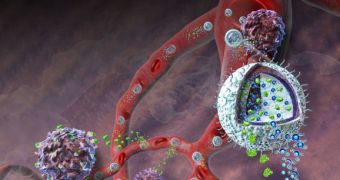A group of investigators from the Yale University announces the development of a new cancer drug, which they say relies on two different types of treatment that were never combined successfully before.
According to the research group, many types of tumors manage to invade the body thoroughly because they can hinder our body's natural biological defenses, and also confuse the immune system. These data led to the development of several therapies meant to address the issues.
Two of the most common revolve around either trying to boost the natural levels of activity displayed by the human system, or focusing on destroying the chemicals released by the tumors, which enable their amazing capabilities.
It's important to note here that scientists have been trying to combine these two approaches in a single vaccine for several years, thus far with limited success. The new investigation, carried out at the Yale University on unsuspecting lab mice, may just be the first study to accomplish this objective.
The research group says that the therapy they developed simultaneously delivers a sustained dose of an immune-system booster, and also a chemical designed specifically to counter the chemical secretion of tumor cells.
Details of how the new approach works were published in the July 15 issue of the top scientific journal Nature Materials. According to the research group, small-scale structures called nanolipogels (NLG) are the backbone of the new technique.
These NLG were outfitted with multiple chemicals, including an inhibitor drug against transforming growth factor-β (TGF-β), one of cancer cells' most important lines of defense. In addition to the inhibitor, the small structures were also outfitted with interleukin-2 (IL-2).
The latter is a protein that plays a very important role in identifying, localizing and addressing threats. It acts by rallying the entire immune system to a spot where infection occurs. This combination, the inhibitor + IL-10, appears to stop tumor growth and promote remission in mice, the team says.
“You can think of the tumor and its microenvironment as a castle and a moat. The 'castles' are cancerous tumors, which have evolved a highly intelligent structure – the tumor cells and vasculature,” explains scientist Tarek Fahmy.
“The 'moat' is the cancer's defense system, which includes TGF-β. Our strategy is to 'dry-up' that moat by neutralizing the TGF-β. We do that using the inhibitor that is released from the nanolipogels. The inhibitor effectively stops the tumor's ability to stunt an immune response,” he adds.
The expert holds an appointment as a Yale University engineering professor. He is also a CAREER grantee with the US National Science Foundation (NSF).

 14 DAY TRIAL //
14 DAY TRIAL //